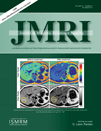Chemical shift sodium imaging in a mouse model of thromboembolic stroke at 9.4 T
Abstract
Purpose:
To estimate changes in the 23Na density and in the 23Na relaxation time T2* in the anatomically small murine brain after stroke.
Materials and Methods:
Three-dimensional acquisition weighted chemical shift imaging at a resolution of 0.6 × 0.6 × 1.2 mm3 was used for sodium imaging and relaxation parameter mapping. In vivo measurements of the mouse brain (n = 4) were performed 24 hours after stroke, induced by microinjection of purified murine thrombin into the right middle cerebral artery. The measurement time was 14 minutes in one mouse and 65 minutes in the other three. An exponential fit estimation of the free induction decay was calculated for each voxel enabling the reconstruction of locally resolved relaxation parameter maps.
Results:
The infarcted areas showed an increase in sodium density between 160% and 250%, while the T2* relaxation time increased by 5%–72% compared to unaffected contralateral brain tissue.
Conclusion:
23Na chemical shift imaging at a resolution of 0.6 × 0.6 × 1.2 mm3 enabled sodium imaging of the anatomical small mouse brain and the acquired data allowed calculating relaxation parameter maps and hence a more exact evaluation of sodium signal changes after stroke. J. Magn. Reson. Imaging 2011;. © 2011 Wiley-Liss, Inc.




